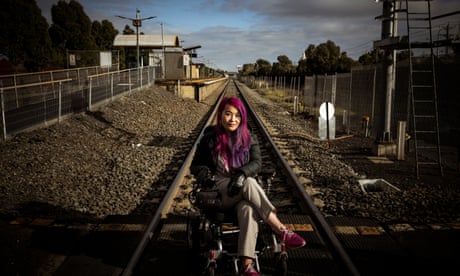- by foxnews
- 08 Apr 2025
Left behind: the fight for accessible public transport in Victoria
Left behind: the fight for accessible public transport in Victoria
- by theguardian
- 13 Jun 2022
- in news

Google Maps tells Akii Ngo it will take 22 minutes to walk to the nearest metropolitan train station. But Ngo knows it will take at least 15 minutes longer than that.
All of this means Ngo is effectively cut off from using public transport in their local area, forced to rely primarily on accessible taxis, which are often unavailable and substantially more expensive than public transport. Even with a multi-purpose taxi-card, a government program that subsidises 50% of the fare, a relatively short trip can cost up to $60.
Ngo is one of a number of activists and advocates who have been fighting for years for fully accessible public transport in Victoria. For their most recent collective action in May, organised by the Disability Resource Centre, they dressed in skeleton costumes and blocked trams on route 19. It was a $100 round trip in an accessible taxi for Ngo to attend.
Fully accessible public transport is federally legislated under the Disability Discrimination Act. In 2002, standards came into effect requiring public transport in all states and territories to be fully accessible by the end of 2022.
That includes all tram, train and bus stops, and captures everything from access paths, ramps, doorways and lifts to toilets, surfaces, hearing augmentation, handrails and grab rails, lighting and signs. The major exceptions are the trams and trains themselves, for which states have another 10 years to roll over their stock.
In Victoria, the most complete data is on the accessibility of tram services. A report published by the auditor general in October 2020 found that in 2018-19, only 15% of tram services delivered a fully accessible service of a low-floor vehicle at a level-access stop.
The report found Victoria was also at risk of not meeting the 2032 compliance date.
Martin Leckey has experience in taking legal action over public transport accessibility. A wheelchair user since a car accident in 1985, Leckey first made a transport complaint under the Disability Discrimination Act in 2002 when the timetable that lists which buses were accessible on his local route was removed.
In the most recent state budget, the Victorian government pledged to build accessible tram stops along La Trobe Street and at the Park Street interchange, as part of a $96m package. The Clifton Hill interchange was not part of that plan.
A Victorian government spokesperson told Guardian Australia that low-floor E-class trams began running along the route in 2020, but the Yarra Trams website says route 30, which runs along La Trobe Street, is currently not serviced by low-floor trams.
According to government figures, low floor trams make up about 40% of the tram fleet, and just over a quarter of tram stops support level access boarding.
The Department of Transport was due to release a strategy at the end of last year that would map the route to full tram accessibility, including priority stops for upgrades, but it never materialised. The Victorian government did not respond to questions about whether the strategy was completed or whether it would be released.
The lack of accessibility keeps people isolated and in poverty, she says.
Leckey is about to embark upon a one-man protest at one of the inaccessible tram stops near his home in Carlton North, which he intends to keep up every sitting day until the government agrees to fund an upgrade.
- by foxnews
- descember 09, 2016
Ancient settlement reveals remains of 1,800-year-old dog, baffling experts: 'Preserved quite well'
Archaeologists have recently unearthed the remarkably well-preserved remains of a dog from ancient Rome, shedding light on the widespread practice of ritual sacrifice in antiquity.
read more


